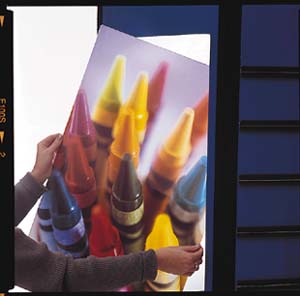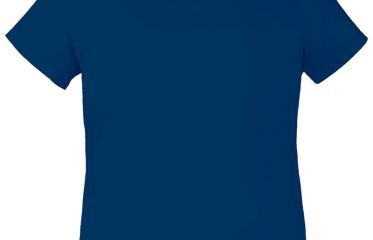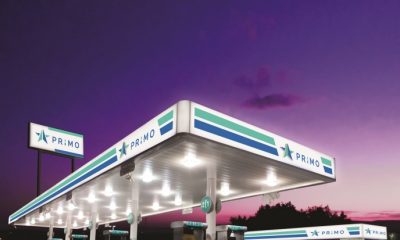Media & Substrates
Published
20 years agoon

Whether they appear on vending machines, nightclub signs, or airport displays, backlit graphics have become an important part of today’s signage and promotional-display industry. The number of rear-illuminated displays is steadily growing, as is the variety and sophistication of the substrates required to produce them. Screen printers have become aware of this developing trend, and many are adding backlit-graphic production to their service offerings. A large number of screen printers also are adding digital-printing systems to their operations.
Whether they appear on vending machines, nightclub signs, or airport displays, backlit graphics have become an important part of today’s signage and promotional-display industry. The number of rear-illuminated displays is steadily growing, as is the variety and sophistication of the substrates required to produce them. Screen printers have become aware of this developing trend, and many are adding backlit-graphic production to their service offerings. A large number of screen printers also are adding digital-printing systems to their operations. Digital-printing technology can be a great complement to the screen-printing process, providing screen shops with the flexibility to go after short-run business from new customers and offer new custom-decorating options to ex-sting customers. However, printers face as many options and challenges in producing backlit displays with digital-output devices as they do when using screen-printing materials and equipment. To develop the highest quality backlit sign, graphics producers must realize the impact of the materials used on the graphic’s final appearance. This article will provide an overview of backlit graphics, describe how they are produced with inkjet printers, and review what types of inkjet inks and substrates should be used for particular backlit applications. It also will address color matching by explaining the differences between reflected color in daylight and backlit color during dark periods and what printers can do to ensure color accuracy in both conditions. Understanding backlit displays Backlit displays are simply graphics that are illuminated from behind. They can be found practically everywhere these days, from retail-store aisles and hotel lobbies to trade-show booths and taxi tops. Backlit displays are not new; they have been around for many years. But recent advancements in digital-printing and media technologies have eliminated some of the production problems of the past, making it easier to produce high-quality, cost-effective backlit graphics. These developments, coupled with the boom in demand for promotional graphics, have resulted in a sharp increase in illuminated signage. A recent report from industry analyst firm CAP Ventures, Norwell, MA, bears this out. The group forecasts that large-format printers will consume 75.5 million sq ft of backlit film in 2003, growing to more than 83.8 million sq ft by 2007. Digital printing has–and will continue to have–a positive impact on the growth of backlit advertisement. Because digital is suited for short- to medium-run lengths, more businesses can afford to include visual displays in their advertising budgets. Therefore, more local and regional venues find installing and leasing backlit space to be a profitable business decision. For example, a local store owner may see great value in placing promotional advertisements in backlit kiosks at a local mall, where foot traffic may be insufficient for a national retailer to consider advertising. The advantage for the print provider is twofold: First, this scenario presents a growing client base. Second, short-run graphics production can be very profitable and generate premium rates. Different types of backlit displays While the demand for backlit signage is increasing, it’s important to note that not all backlits are created equal. The hardware and media requirements for backlits differ based on the application. For example, transit-shelter backlit displays generally require that the graphic be placed between two sheets of rigid Plexiglas. Complex and curved backlit signs, such as bus-side displays, vending machines, and taxi-top displays, require a printed, backlightable, adhesive film to be adhered to a single sheet of Plexiglas. The following is a short overview of the most common types of backlit formats and media: Calendered vinyl with pressure-sensitive adhesive (PSA) on one side commonly is used for producing backlit signage. Vinyl is cheap, flexible, and durable. The adhesive enables graphics to be applied without the need for mounting hardware associated with rigid and non-adhesive media. The adhesive must be reworkable and aggressive, yet easy to remove at the end of the promotion. While on display, the vinyl must remain stable and not separate from the surface. Depending on the longevity of the promotion, the vinyl may be protected with a pressure-sensitive overlaminate.Ed McCarron, Larry Delesio, and Wendi West – InteliCoat Technologies Polyester backlit films can be slid in between two pieces of Plexiglas for protection. Depending on the type of polyester media and the length of time the display will be exposed outdoors, the material may feature a water-resistant coating and may or may not require overlamination after printing. Polyester films also can be mounted to a pressure-sensitive clear backer for additional rigidity or to Plexiglas or acrylic panels with an optically clear pressure-sensitive adhesive. Papers that have good uniformity can be used for backlit signage. However, paper products should be overlaminated, edge-sealed, and protected with Plexiglas. Papers are not as dimensionally stable as vinyls or polyester films. Producing a backlit graphic Backlit graphics are most commonly produced using one of three printing methods: screen printing, inkjet imaging, or photo laser printing. The type of printing technology used to produce backlit graphics depends on several factors, the most important being the life span desired from the printed graphic and the volume of graphics required. For example, screen printing is the best method for producing a large volume of backlit graphics that are meant to have a long life span. Screen printing offers superior production speed and uses the most durable inks. The new generation of grand-format and solvent inkjet printers has become a popular choice for screen printers who have committed to incorporating digital production. These machines also offer a good solution for producing long-lasting backlit graphics, particularly for outdoor displays such as transit shelters. Grand-format printers offer good resolution (in excess of 600 dpi, in some cases) and high print speeds, making them ideal for large graphic applications. While grand-format and solvent inkjet printers are primarily designed for printing on uncoated vinyl, a growing number of substrates for producing backlit graphics also have become available. The production speed and outdoor durability of these systems, coupled with the new generation of specialty films and papers, can provide a great solution for outdoor backlit displays. For a smaller quantity of short- or medium-term graphics, such as indoor P-O-P displays, a mid-format thermal or piezoelectric inkjet printer may be a more cost-effective solution. To choose the right type of substrate for your backlit graphics, it is important to know the differences between these inkjet technologies. Differences between mid-format thermal and piezo inkjet printers Thermal and piezoelectric inkjet printers both deposit ink droplets onto media by applying electrical signals to the printhead. What is different is the method used to expel the ink. Thermal inkjet printers use heat, whereas piezoelectric printers use a form of vibration. Piezo printers enjoy several advantages over thermal inkjet printers. For example, piezo printers can use a wider range of inks, including solvent-based and aqueous inks that incorporate either dyes or pigments. In general, these inks are formulated to dry more quickly than the inks used in thermal inkjet printers, and consequently, piezo printers usually can print at more rapid speeds. Thermal inkjet printers only use water-based (aqueous) inks, also in dye-based and pigmented formulations. These inks take longer to dry between print passes, affecting print speed. In addition, heat buildup in the printheads can cause color shifts. However, thermal inkjet is one of the most common printing technologies used in the market today. As a result, there is a wider variety of media choices available for thermal systems. Choosing the right media As film coatings and inks continue to improve, the opportunities to produce a variety of backlit display graphics with mid-format inkjets do as well. However, matching the media options with the right technology and intended application can be a challenge. The cost, output-quality, and finishing requirements of each job are key factors to consider when choosing a backlit media. Some designers prefer to use paper rather than film as a cheaper way to produce backlit displays. This approach to saving money can backfire, however, because paper is less durable than film, even when encapsulated in Plexiglas. While films for mid-format inkjets may be more expensive (because they must be coated to accept the prints), they provide far more durability than paper, yielding greater economies in the long run. The type of inks used in the different printers plays an important role in deciding which type of media to use for backlit applications. Dye-based inks have a wide color gamut and excellent transmission characteristics, but a limited life span due to their tendency to fade from UV exposure or oxidation. When printed, dye inks will absorb into the coating of the substrate. Therefore, when illuminated, the light will diffuse into the coating and the base material, which is now saturated with ink, thus illuminating the graphic evenly. Since diffusion of light is desirable, dye inks should be printed on media designed for second-surface (back-surface) printing (Figure 1). The materials require the image to be inverted during printing to appear right-reading when viewed through the film. The film itself becomes a protective barrier between the viewing side and the printed side. Pigmented inks do not manage transmitted light in the same manner as dye inks. Pigment particles sit on top of the coated substrate, creating their own diffusion of light. Therefore, front-print substrates (Figure 2) are advisable when using pigmented inks, since they position the ink closer to the viewer, allowing less interference between the ink and the eye. Media texture also is an important consideration. For example, trade-show booth panels often use light boxes of different sizes to protect the backlit design. A textured polycarbonate (Figure 3) is ideal for creating backlit panels for trade-show displays because the surface does not produce any glare when viewing from short distances. In contrast, glare increases dramatically when using a matte- or gloss-coated film. Keep in mind that a range of different light sources are used in today’s light boxes. The strength and orientation of the bulb(s) plays a huge role in how "illuminated" a printed image will appear when backlit. Imaging requirements for a backlit graphic The most important parameters to take into consideration when producing graphics for backlit applications is where the graphics will be used, how they’ll be viewed, and how long they need to last. This information will determine the best methodology for producing the graphic. To understand some of these requirements and expectations, it is critical to develop a dialogue with the customer. When it comes to images, request that the photographer or designer provide the final image as a positive transparency film or chrome. Chromes need to be scanned and viewed as a positive transparency. This will help when proofing the final backlit with the original film, since both are viewed as backlit images. Contrast in the image also is key to making them look good; check the "Histogram" in Photoshop or your RIP program to verify that you have adequate contrast. If necessary, reset the highlight and shadows tones of the image to provide maximum contrast. Graphics look very different if they are reflective rather than transmissive, particularly from one backlit substrate to the next. Reflective prints are viewed with light from an external light source (daylight, spot lights, etc.) The light passes through the ink and simply reflects off the base material through the ink to reach the viewer. In transmissive viewing, light is projected through both the substrate and ink to reach the viewer, and the combination of media, ink, and fixed light source has a greater impact on how the viewer perceives the graphic. Change just one of these elements and a completely different result is visible. To achieve accurate color for tranmissive-viewing applications, it’s essential that you calibrate the printing system (defined by the printer/ink/media/software combination) and characterize its performance with a profile for the application and viewing conditions. To do this, you need a transmissive spectrophotometer (Figure 4). This device projects light through the printed translucent substrate to an optic sensor. It takes into account and successfully adjusts for the critical interaction of light through ink on a transmissive substrate. If the backlit graphic is going to be viewed as a reflective image during the day and a transmissive print at night, you must take color accuracy under both conditions into consideration. Because it is not possible to have the same graphic calibrated and profiled for both conditions, you should look for a substrate that exhibits only a small color shift between reflective and transmissive viewing. Images printed second-surface on backlit materials are not viewable without backlighting, so they are not usable in applications requiring reflective viewing. For graphics that must be viewed in both daylight and backlit conditions, you are limited to printing first-surface on films and papers that appear to be opaque until the rear illumination has been turned on. Before selecting media, test available materials that meet these criteria with different light. If possible, calibrate and profile the graphic for backlighting, then tweak the density or brightness of the final color setup to achieve an acceptable appearance under reflective-viewing conditions. Mounting a backlit display When it comes to mounting backlit graphics, you have a wide range of options from which to choose. For example, the placement, temperature, and desired life span of the sign may dictate that a printed graphic film be adhered directly to Plexiglas. In this situation, it would be important to use an optically clear adhesive, otherwise the pattern of the adhesive will show through when lit. Many backlit boxes are designed so that the poster is installed by sliding it between the two sheets of Plexiglas. The media used for the backlit poster either should have the dimensional stability and rigidity to stand flat between the sheets throughout the life of the promotion, or the poster material should be laminated to provide these properties. Also consider whether or not the display will continually be backlit. For example, a visual advertising campaign in one city may include backlit graphics for a hundred or more transit shelters. Some of these shelters may be backlit while others are not. In this case, it would advisable to choose a print media that displays well when frontlit or backlit. Lighten up Whether you use a thermal or piezoelectric printer, you can find backlit films and papers that will provide durable and attractive results. Your goal should be to select a combination of material and ink system that best satisfies the application criteria, then measure the printed results you get with these components to verify that the colors are acceptable for the lighting conditions in which the graphic will be viewed. Producing backlit graphics digitally takes a little practice, but once you’ve mastered the technique, your customers will glow with appreciation. Tips for creating effective backlit-display graphics * Identify the customer’s needs: specific application, longevity requirements, budget, expectations, etc. * Match the application to the appropriate printer. * Match the right media to the printer and ink. * Don’t try to achieve "false economies" by skimping on media quality– cutting corners up front may cost you more in the end. * Calibrate and profile your printer for best results. * Understand the light source with which the graphic will be displayed. * Take into account the performance requirements of the different mounting options. Ed McCarron Ed McCarron is product manager for display media with InteliCoat (formerly Rexam Image Products), South Hadley, MA. McCarron oversees market development for the company’s line of large-format media to the signage and graphics markets. He has shared his knowledge about digital media, printing, and finishing by training printers across the US and in 17 countries. With InteliCoat since 1986, McCarron also has served as applications technologist in the company’s applications laboratory. Larry Delesio Larry Delesio is a digital-graphics specialist for InteliCoat’s technical services lab, where his responsibilities include illustration and design, technical support, and print-sample generation, as well as digital photography and art direction. Delesio also provides trade-show support, creates ICC profiles, conducts product evaluation, and leads audio and video production and digital-printing-system integration. Delesio joined InteliCoat in 1995. Wendi West Wendi West is a product engineer for InteliCoat’s technical services lab. She is responsible for defining product performance, identifying product-operating windows, and understanding product consistency and variability for InteliCoat’s media offerings. With InteliCoat for five years, West also conducts competitive analyses, develops test-appraisal systems, and supports other functions within the company.

Subscribe

Magazine
Get the most important news
and business ideas from Screenprinting Magazine.
Most Popular
-

 Case Studies2 months ago
Case Studies2 months agoHigh-Density Inks Help Specialty Printing Take Center Stage
-

 Art, Ad, or Alchemy2 months ago
Art, Ad, or Alchemy2 months agoF&I Printing Is Everywhere!
-

 Andy MacDougall2 months ago
Andy MacDougall2 months agoFunctional and Industrial Printing is EVERYWHERE!
-

 Columns3 weeks ago
Columns3 weeks ago8 Marketing Mistakes Not to Make When Promoting Your Screen Printing Services Online
-

 Editor's Note2 weeks ago
Editor's Note2 weeks agoLivin’ the High Life
-

 Thomas Trimingham2 months ago
Thomas Trimingham2 months ago“Magic” Marketing for Screen Printing Shops
-

 Marshall Atkinson2 weeks ago
Marshall Atkinson2 weeks agoHow to Create a Winning Culture in Your Screen-Printing Business
-

 News & Trends1 month ago
News & Trends1 month agoWhat Are ZALPHAS and How Can You Serve Them in Your Print Business?






